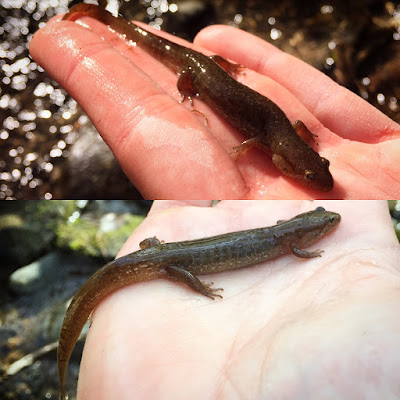Pink Lady Slippers
Looks Like: A large, showy wildflower of the Orchid Family. It has two opposite basal leaves and a large flower at the end of an erect stalk. The flower can be magenta to white-pink. The plant can grow 6-15” in height.
 |
| First Emergence on the Preserve - May 12 |
Lives In: A variety of habitats and can be found in hardwood, coniferous forests of pine and hemlock. They also can be found on rocky and mossy slopes (similar to much of the habitat found on the Shawangunk Ridge). Pink Lady Slippers prefer to grow in areas of disturbance in these forests.
Niche: In order to survive and reproduce, the Pink Lady Slipper needs to interact with a fungus in the soil in order to grow and bees in order to reproduce. The Orchid seeds do not have food supplies inside them like most seeds. The Pink Lady Slipper seeds require the threads of fungus to break open the seed and attach them to it. Once attached the fugue will pass on food and nutrients for growth and survival. When the plant is able to produce most of its own food, the fugue will extract nutrients from the orchid roots – a symbiotic or mutually beneficial relationship occurs. Pink Lady Slippers have closed flowers and only certain animals can enter and exit the small opening in the front. The bee is tricked into thinking the orchid holds nectar due to a sweet-smelling aroma the flower expels. As the bee tries to exit the flower, it gets covered in the flower’s pollen. If the bee gets tricked by another Pink Lady Slipper, it will deliver pollen from the first flower and help with the start of reproduction.
Also, White-Tailed Deer love this plant as a food source.
Threats: Pink Lady Slippers can be found in the Shawangunk woodland areas, however, they take a very long time to grow. Picking these flowers is not recommended.
Frequency: They are a common wildflower in the Shawangunks.
Reproduction: Flowers in early to Mid-May into July.
Fun Fact: Another common name for the Pink Lady Slipper is the Moccasin Flower as the flower looks like a shoe. The roots were used as a remedy for nervousness, tooth pain, and muscle spasms.
 |
| And on a RARE occasion, you get a double Pink Lady Slipper! Found by one of my volunteers, this was an amazing find! They look like a pair of Ballet Shoes! |
























